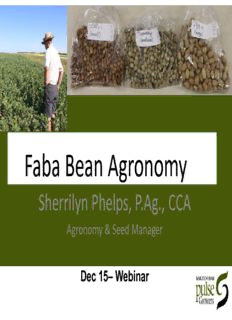
Faba Bean Agronomy PDF
Preview Faba Bean Agronomy
Faba Bean Agronomy Sherrilyn Phelps, P.Ag., CCA Agronomy & Seed Manager Dec 15– Webinar Topics to Cover • Why faba beans • Agronomics • 2015 Experience Source: S. Phelps, SPG 2015 Interest in faba beans Acreage in Western Canada – Crop Insurance Acreage Year AB SK MB Total 2014 80,000 20,000 100,000 2015 110,000 61,792 9,040 >180,000 2016 ??? ??? ??? ??? Why interest in faba bean? 1. Wet years/springs – still want a pulse Water Response of Faba Bean Alberta Agriculture (1974-77, Vauxhall and Brooks) For full yield potential need lots of moisture!! • 8-10 inches suggested • Spring soil moisture + 44.5 rainfall or irrigation bu/acre 300 mm moisture 2. Aphanomyces Root Rot • Faba beans varieties have more tolerance than pea but similar to chickpea 100 90 t o 80 o n r o 70 r i o t a 60 ) r % u 50 ( o y ol 40 t i c r s 30 e i d v 20 e S 10 0 4 1 6 1 3 0 2 9 1 1 4 1 5 r w e 4 t a d p 1 o r o 186- 1865-1 219-1 233- 247-1 346-1 406- 510- 512-1 528-3 551- 708- tz/Br 9 Frontie Meado Fabell FB9- Floren Impos nowbir owdro SSNS- abassc Taboa Vertig Bli DC C S Sn T D C C 3. Standability is good Faba beans Peas Photo: S. Phelps, SPG from Medstead, September 2015 4. Nitrogen Fixation Potential Faba bean are the highest N-fixing legume grain crop N fixed in Western Canada (dryland) lbs N / acre Alfalfa 100 - 250 Pea 50 - 150 Lentil 30 - 120 Chickpea 20 - 100 Dry Bean 5 - 70 Faba Bean 80- 160 Source: Dr. J. Schoenau, U of Saskatchewan Significant $ Value Actual amount depends on inoculation/nodulation, environmental conditions, soil available N and other nutrients like P. 5. Tolerance to Spring Frosts -Growing points below soil surface -Seed early
Description: